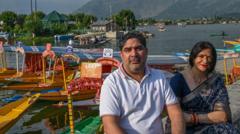The aftermath of a deadly attack on tourists in Indian-administered Kashmir, which resulted in the tragic deaths of 26 individuals, has left an indelible mark on the region's tourism sector. However, two months post-incident, the picturesque valley is starting to experience the first signs of a tourism revival. Families like the Awwals from Rajasthan, despite the grim events of April, chose to visit Kashmir, confident about their safety and eager to enjoy the landscape.
Ms. Awwal, armed with nostalgic memories of her prior visits, states, "We wanted to show all these places to our relatives," emphasizing their determination to visit despite the reported dangers. Following the attack, a mass wave of tourists canceled or scaled back their trips, prompting the closure of 48 tourist destinations across the valley. Chief Minister Omar Abdullah admitted the attack caused a sharp decline in visitors and called this season a disaster for tourism.
Nonetheless, the spirit of travel seems resilient, with optimistic families ignoring negative portrayals in the media. Tourists like Deepti and Anuj Gandhi reaffirm their tradition of visiting Kashmir, citing its unmatched scenic beauty as their only destination. Their words echo a renewed sense of hope among hoteliers and local businesses, who rely on tourism for their livelihoods.
Encouraged by a surge in local and even international visitors, including a recent group of Polish tourists, the tourism industry is beginning to bounce back. Haji Wali Mohammad Bhat, president of the shikara owners' association, stated, "Tourists are our life, tourism is our lifeline." Meanwhile, the introduction of a new train link between Srinagar and Katra has invigorated travel plans, connecting Kashmir with other major areas in India.
As tourists declare their defiance against fear and choose to explore Kashmir’s stunning landscapes, local leaders, including Chief Minister Abdullah, see potential for a brighter future for tourism. With cautious optimism, the valley hopes to foster lasting confidence among travelers and promote longer stays in the region. While challenges remain, the collective sentiment is that the inherent beauty and resilience of Kashmir will draw visitors back to its breathtaking landscapes.


















